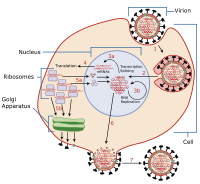
Photo from wikipedia
Abstract Many seminal advances have been made in human immunodeficiency virus (HIV)/AIDS research over the past four decades. Treatment strategies, such as gene therapy and immunotherapy, are yielding promising results… Click to show full abstract
Abstract Many seminal advances have been made in human immunodeficiency virus (HIV)/AIDS research over the past four decades. Treatment strategies, such as gene therapy and immunotherapy, are yielding promising results to effectively control HIV infection. Despite this, a cure for HIV/AIDS is not envisioned in the near future. A recently published academic study has raised awareness regarding a promising alternative therapeutic option for HIV/AIDS, referred to as “selective elimination of host cells capable of producing HIV” (SECH). Similar to the “shock and kill strategy,” the SECH approach requires the simultaneous administration of drugs targeting key mechanisms in specific cells to efficiently eliminate HIV replication-competent cellular reservoirs. Herein, we comprehensively review the specific mechanisms targeted by the SECH strategy. Briefly, the suggested cocktail of drugs should contain (i) latency reversal agents to promote the latency reversal process in replication-competent reservoir cells, (ii) pro-apoptotic and anti-autophagy drugs to induce death of infected cells through various pathways, and finally (iii) drugs that eliminate new cycles of infection by prevention of HIV attachment to host cells, and by HIV integrase inhibitor drugs. Finally, we discuss three major challenges that are likely to restrict the application of the SECH strategy in HIV/AIDS patients.
Journal Title: Chinese Medical Journal
Year Published: 2021
Link to full text (if available)
Share on Social Media: Sign Up to like & get
recommendations!